User Guide
Introducing CallMeMaybe
CallMeMaybe (CMM) is a desktop app that helps Singaporean Telemarketers in customer contact management. CMM provides a solution to quickly catalog contacts based on whether they have already been called or not. The in-built tracking functionality serves as a reminder for you to reach back on previously unreachable customers. Importing and exporting of existing customer database is also supported by CMM to facilitate team-based environments.
CMM is optimized for use via a Command Line Interface (CLI) while still having the benefits of a Graphical User Interface (GUI).
If you can type fast, CMM can get your contact management tasks done faster than traditional GUI apps.
Navigating the User Guide
This user guide aims to help you easily find the information you desire for any command.
Each Command section is separated into:
-
Brief description of the command
-
Command Format
-
Things to note
-
Example
-
Common issues
Throughout this guide, you may encounter the following icons:
-
 Caution: Warns you about possible irreversible behaviours
Caution: Warns you about possible irreversible behaviours
-
 Notes: Provides general information that you might find useful
Notes: Provides general information that you might find useful
-
 Tip: Provides useful practical advice about their respective features
Tip: Provides useful practical advice about their respective features
![]() Note: Straightforward commands such as
Note: Straightforward commands such as clear may not have the sections “Things to note”, “Example” and “Common issues”
It is highly recommended that you familiarise yourself with the Command Notations we use.
For new users, head over to Quick Start to get started. You can learn the command notations along the way as well.
For more experienced users, feel free to skip over to the Features section to check out detailed descriptions of the features we offer.
If you have any questions about CMM, please refer to the FAQ.
Hope you have a great time with CMM.
1. Table of Contents
- Introducing CallMeMaybe
- Navigating the User Guide
- 1. Table of Contents
- 2. Quick start
- 3. Interface layout
- 4. Command Notations
-
5. Overview of Features
- 5.1 Adding a contact:
add - 5.2 Listing all contacts :
list - 5.3 Marking a contact as called :
called - 5.4 Editing a contact :
edit - 5.5 Deleting a contact :
delete - 5.6 Finding contacts that match ANY of the keywords specified:
findAny - 5.7 Finding contacts that match ALL the keywords specified :
findAll - 5.8 Displaying full contact details :
display - 5.9 Filtering contacts :
filter - 5.10 Clearing all contacts :
clear - 5.11 Viewing help :
help - 5.12 Exiting the program :
exit - 5.13 Saving the data
- 5.14 Importing the data into database
- 5.15 Exporting state of database
- 5.16 Editing the data file (JSON)
- 5.1 Adding a contact:
- 6. FAQ
- 7. Troubleshooting
- 8. Command summary
2. Quick start
-
Ensure you have Java 11 or above installed in your computer. You can learn how to install the latest version of Java here. If you already have Java installed, you can follow these steps to check if you have an appropriate version of java.
-
Download the latest CallMeMaybe.jar from here.
-
Copy the file to the folder you want to use as the home folder for CMM.
-
Double-click the file to start the app. A prompt will popup asking whether you want to import any new contacts. The prompt will look like the screenshot below :
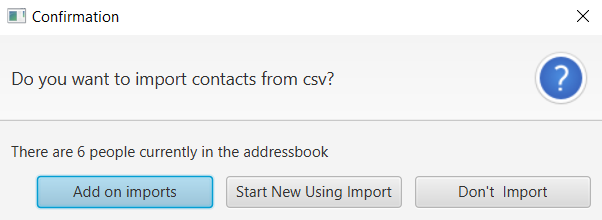
To learn more about what each option does in detail, click here. An example file import can be downloaded here -
After you click any button on the prompt, CMM will execute the selected option, and a GUI similar to the screenshot below should appear in a few seconds. Note how the app contains some sample data upon first startup.
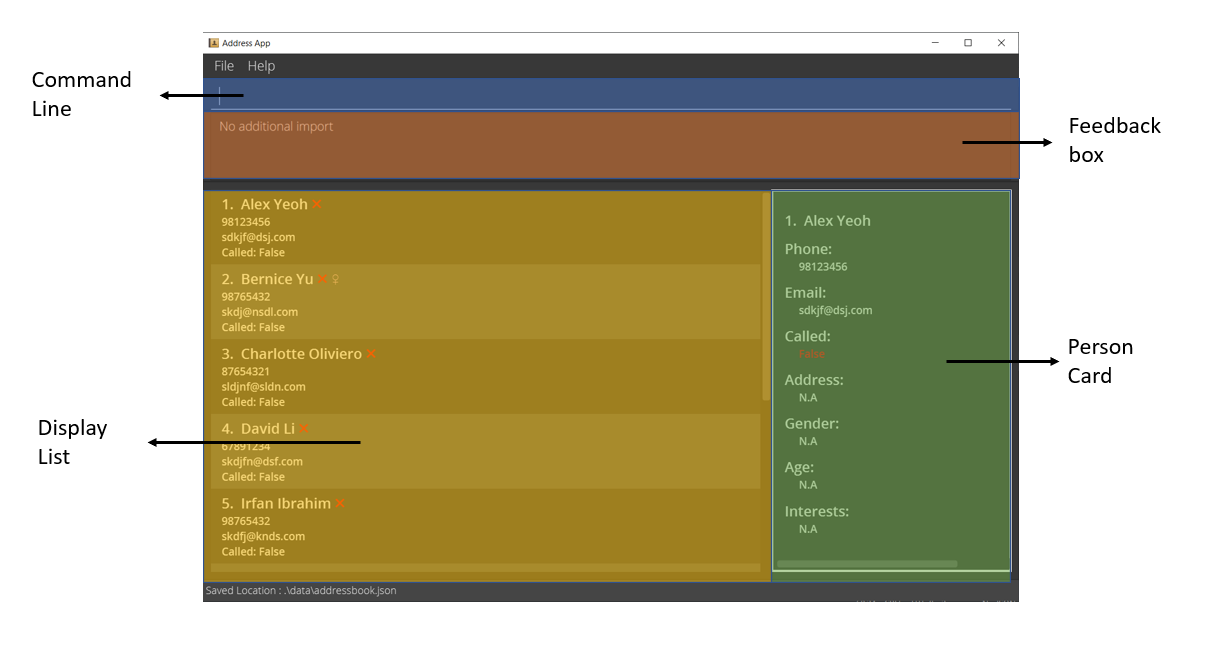
- Type the command in the command box and press Enter to execute it. e.g., typing “help” and pressing
Enterwill open the help window. You can find the commands that CallMeMaybe supports below:-
add n/John Doe p/98765432 e/johnd@example.com: Adds a contact named John Doe to the CMM database -
list: Lists all contacts -
called 2: Marks the 2nd contact shown in the current list as called -
edit 1 n/Bob p/62353535: Edits the name and phone number of the first contact in the displayed list -
findAny n/alex g/m: Finds the contacts that have the substringalexin their name AND/OR are males -
findAll n/alex g/m: Finds the contacts that have both the substringalexin their name AND are males -
delete 3: Deletes the 3rd contact shown in the current list -
display 4: Displays the full contact details of the fourth contact in the displayed list -
filter called: Sorts the list to display uncalled contacts first -
clear: Deletes all contacts -
exit: Exits the app
-
-
Remember to clear the sample data using
clearcommand before adding your own data. - Refer to the Features below for details of each command.
3. Interface layout
Command Panel

Image of CMM’s Command Panel
-
Commands are entered in the Command Line (section labeled
Enter command here...) -
The Feedback Box (the bottom section) displays the result of the command, which can be an error message if the command is invalid
Display List
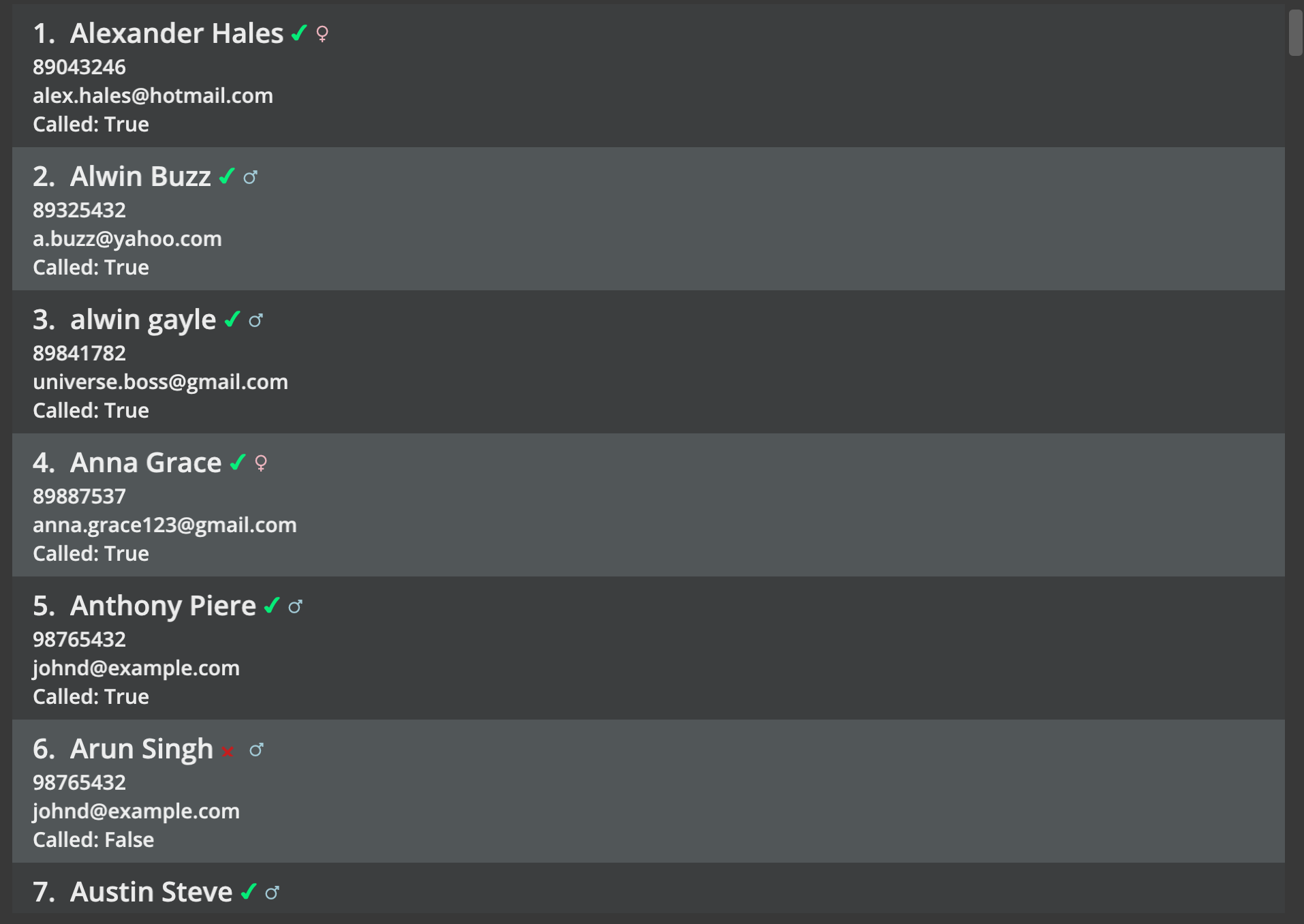
Image of CMM’s Display List
- Displays the list of contacts along with their contact details which includes the name, phone number, email address and isCalled attributes
Person Card
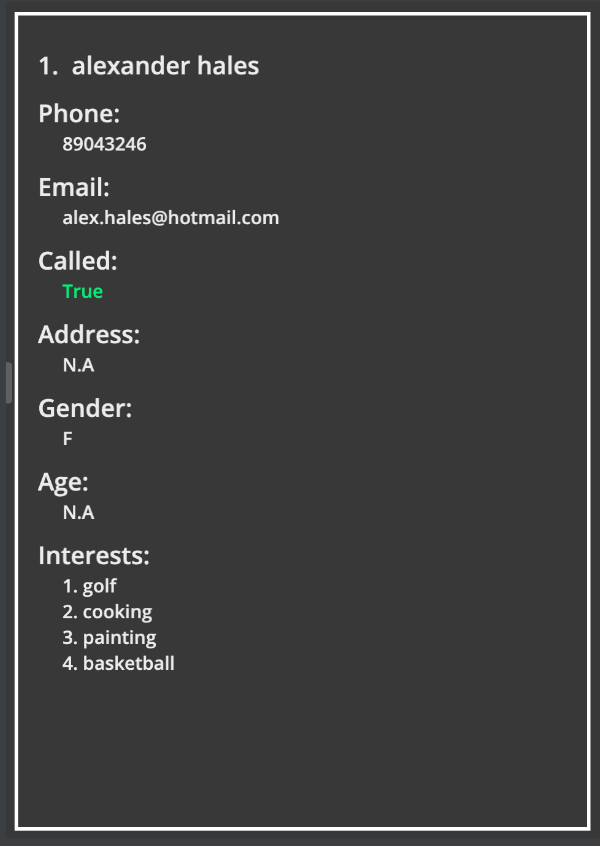
Image of CMM’s Person Card
-
Displays additional information of each contact in the list of contacts. This includes the attributes age, gender, address and interests
-
When application is started, the first contact in the list is displayed. If the contact list is empty, CMM displays an ‘empty contact’ with all the fields set to ‘N.A’
4. Command Notations
![]() Notes about the command format:
Notes about the command format:
-
Words in
UPPER_CASEare the parameters to be supplied by the user
e.g., inadd n/NAME,NAMEis a parameter which can be used asadd n/John Doe -
Items in square brackets are optional
e.g.,n/NAME [g/GENDER]can be used asn/John Doe g/Mor asn/John Doe -
Items with
… after them can be used multiple times including zero times
e.g.,[i/INTEREST]…can be used as ` ` (i.e., 0 times),i/running,i/running i/watching tvetc -
Parameters can be in any order
e.g., if the command specifiesn/NAME p/PHONE_NUMBER,p/PHONE_NUMBER n/NAMEis also acceptable -
If a parameter is expected only once in the command is specified multiple times, only the last occurrence of the parameter will be taken
e.g., if you specifyp/99998888 p/66667777, onlyp/66667777will be taken -
Extraneous parameters for commands that do not take in parameters (such as
help,list,exitandclear) will be ignored
e.g., if the command specifieshelp 123, it will be interpreted ashelp
5. Overview of Features
5.1 Adding a contact: add
Adds a contact to the CMM database.
Format: add n/NAME p/PHONE_NUMBER e/EMAIL [a/ADDRESS] [g/GENDER] [age/AGE] [i/INTEREST]…
Things to note:
-
Name,Phone_numberandEmailfields are mandatory -
Namemust contain only alphanumeric characters -
Phone_numbermust contain exactly 8 digits -
numbers must start with “6”, “8” or “9”
-
Emailshould be in the form oflocal-part@domain-name-
The local-part should only contain alphanumeric characters and these special characters,
+_.- -
The local-part may not start or end with any special characters
-
The domain-name is made up of domain labels separated by periods (eg. @nus.edu.sg)
-
The domain-name must end with a domain label at least 2 characters long
-
The domain-name must have each domain label start and end with alphanumeric characters
-
The domain-name must have each domain label consist of alphanumeric characters, separated only by hyphens, if any
-
-
Gendercan only be “m”, “f”, “n.a” (case-insensitive) -
Agemust only contain numbers -
AddressandInterestcan be in any format -
All the fields are case-insensitive
Address, Gender, Age, Interest fields are optional. A contact can have multiple interests.
Example:
-
add n/Betsy Crowe p/92345679 e/betsycrowe@example.com a/her house i/running i/swimming i/eatingAdds a contact with the following fields:-
Name: Betsy Crowe -
Phone: 92345679 -
Email: betsycrowe@example.com -
Address: her house -
Intrests: running, swimming, eating -
All other unspecified fields will be set to N.A by default
-
The screenshot below shows the expected result. To display the full contact details, you can use the display command.
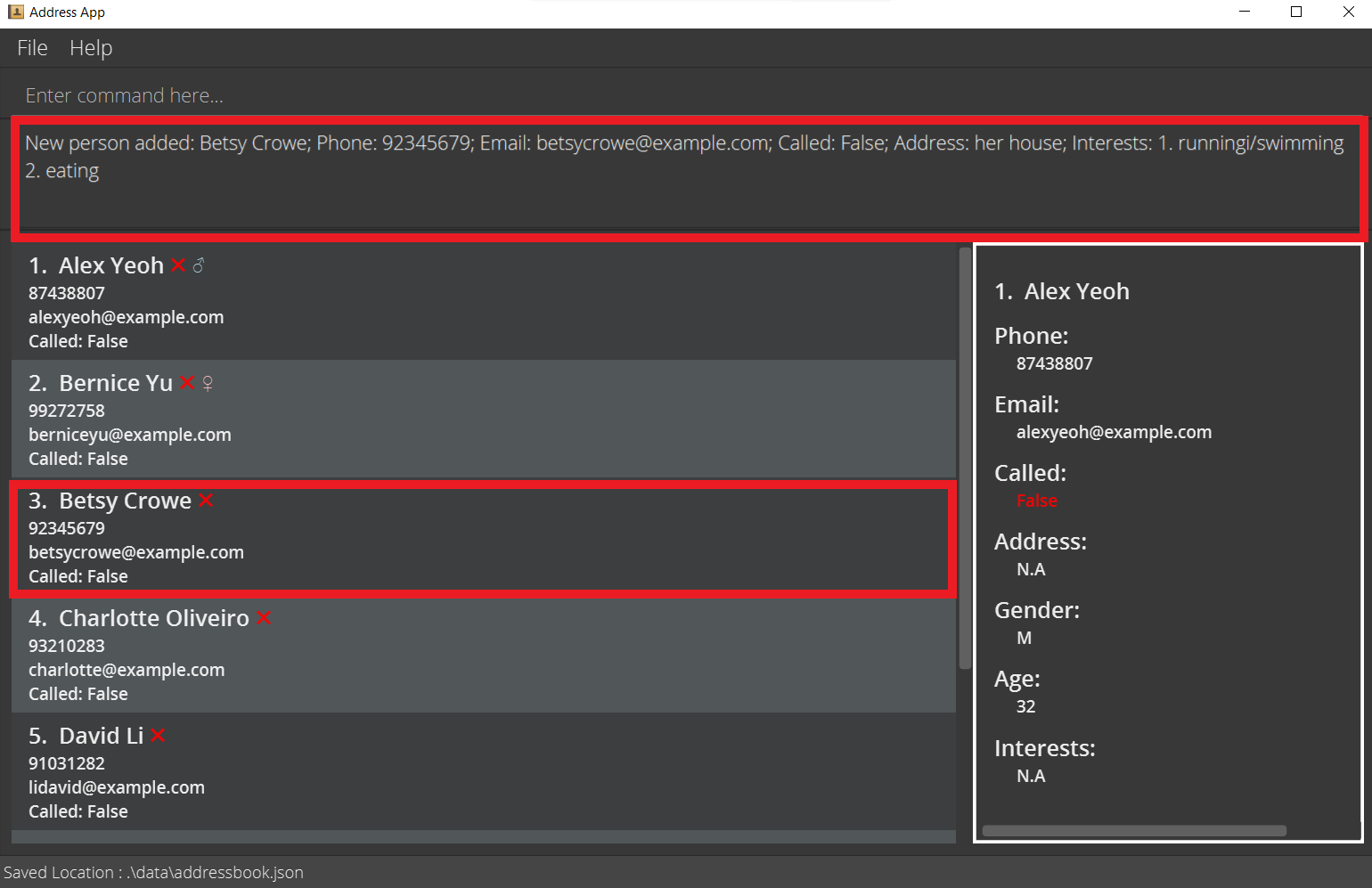
Common issues:
-
Invalid command format!:
a. Omitted one or more of the mandatory fields
b. Used the wrong prefix (e.g., ‘/n’ instead of ‘n/’)
5.2 Listing all contacts : list
Shows a list of all contacts in the CMM database.
Format: list
Things to note:
-
listshows all contacts in ascending order by name
The screenshot below shows the expected result.
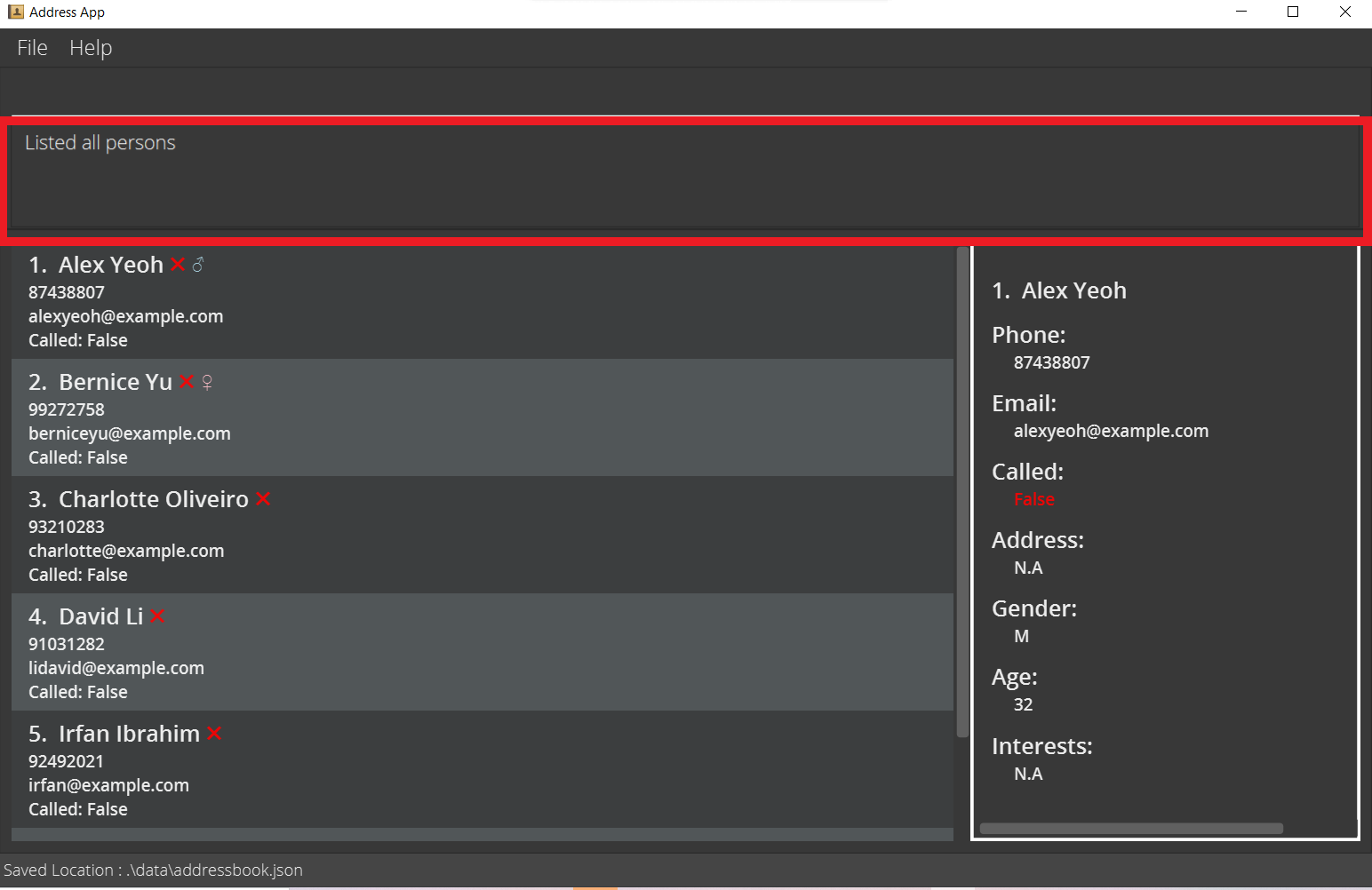
5.3 Marking a contact as called : called
Marks the specified contact from the address book as called. (i.e., contact has already been called)
Format: called INDEX
Things to note:
-
INDEXrefers to the index number shown in the displayed list -
INDEXmust be a positive integer (e.g., 1, 2, 3, …) -
If
INDEXis valid, theCalledfield will be updated to ‘True’ -
No changes would be made if the
Calledfield is already ‘True’ -
If you want to un-call a contact, use the edit command
Example:
-
called 3marks the 3rd contact in the displayed list as Called
The screenshot below shows the expected result. Note how the “❌” changes to a “✔️”.
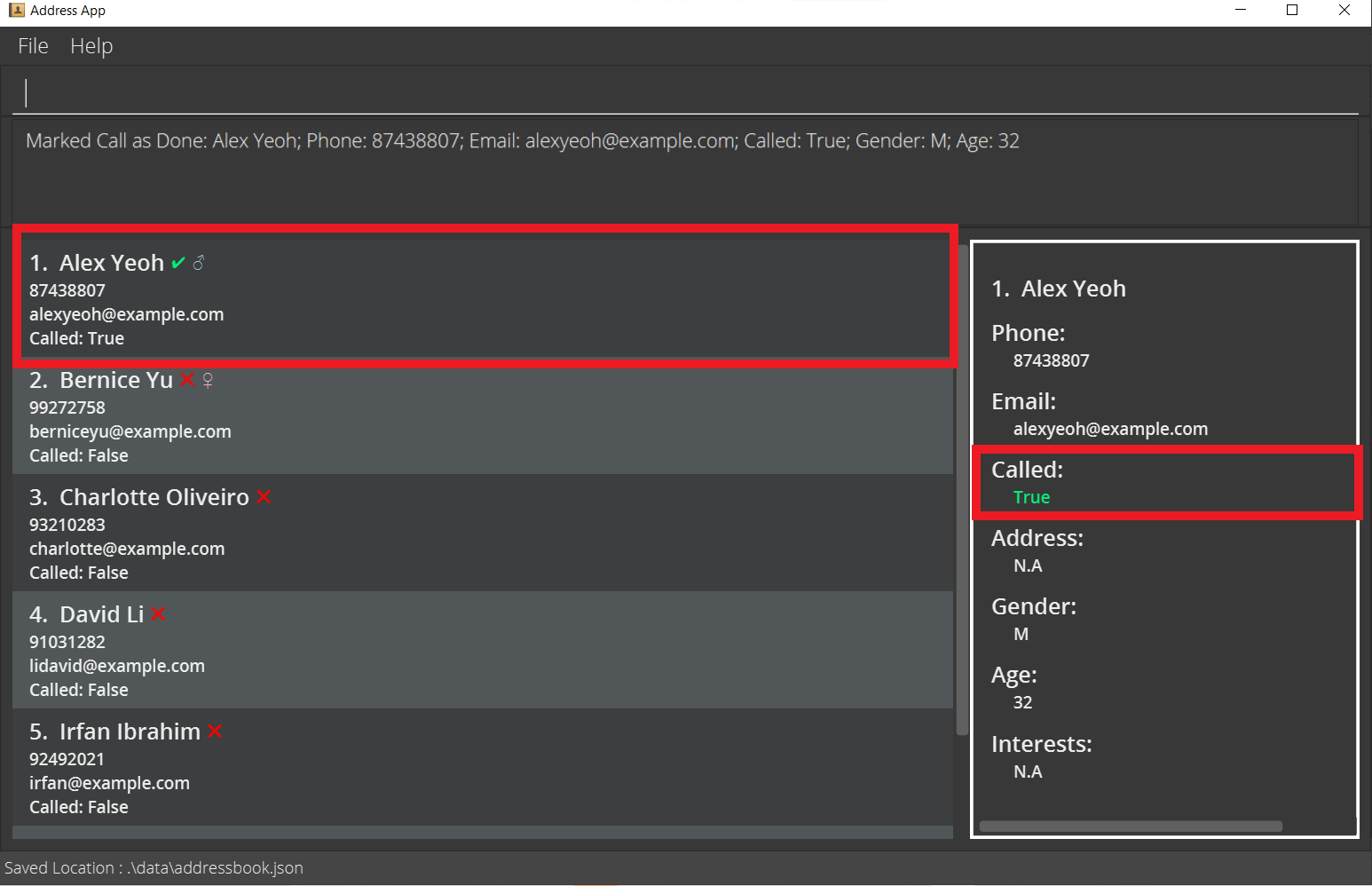
Common issues:
-
The index provided is invalid:
a. Displayed list does not contain contact at
INDEXb. Index specified is larger than 2147483647
c. Index specified is not a positive integer
5.4 Editing a contact : edit
Edits an existing contact in the CMM database.
Format: edit INDEX [n/NAME] [p/PHONE] [e/EMAIL] [a/ADDRESS] [g/GENDER] [age/AGE] [c/CALLED] [i/(OPTIONAL INTERESTSLIST INDEX) INTEREST]...
[i/(INTERESTSLIST INDEX) remove]... [i/INTEREST]..
Things to note:
-
All the fields are case-insensitive
-
INDEXrefers to the index number shown in the displayed list -
INDEXmust be a positive integer (e.g., 1, 2, 3, …) -
INTERESTSLIST INDEXrefers to the index number shown in the displayed interests list of the contact -
INTERESTSLIST INDEXmust be a positive integer (e.g., 1, 2, 3, …) -
You can find the Interests list of a contact here (refer to the screenshot below) and can be displayed by using the display command
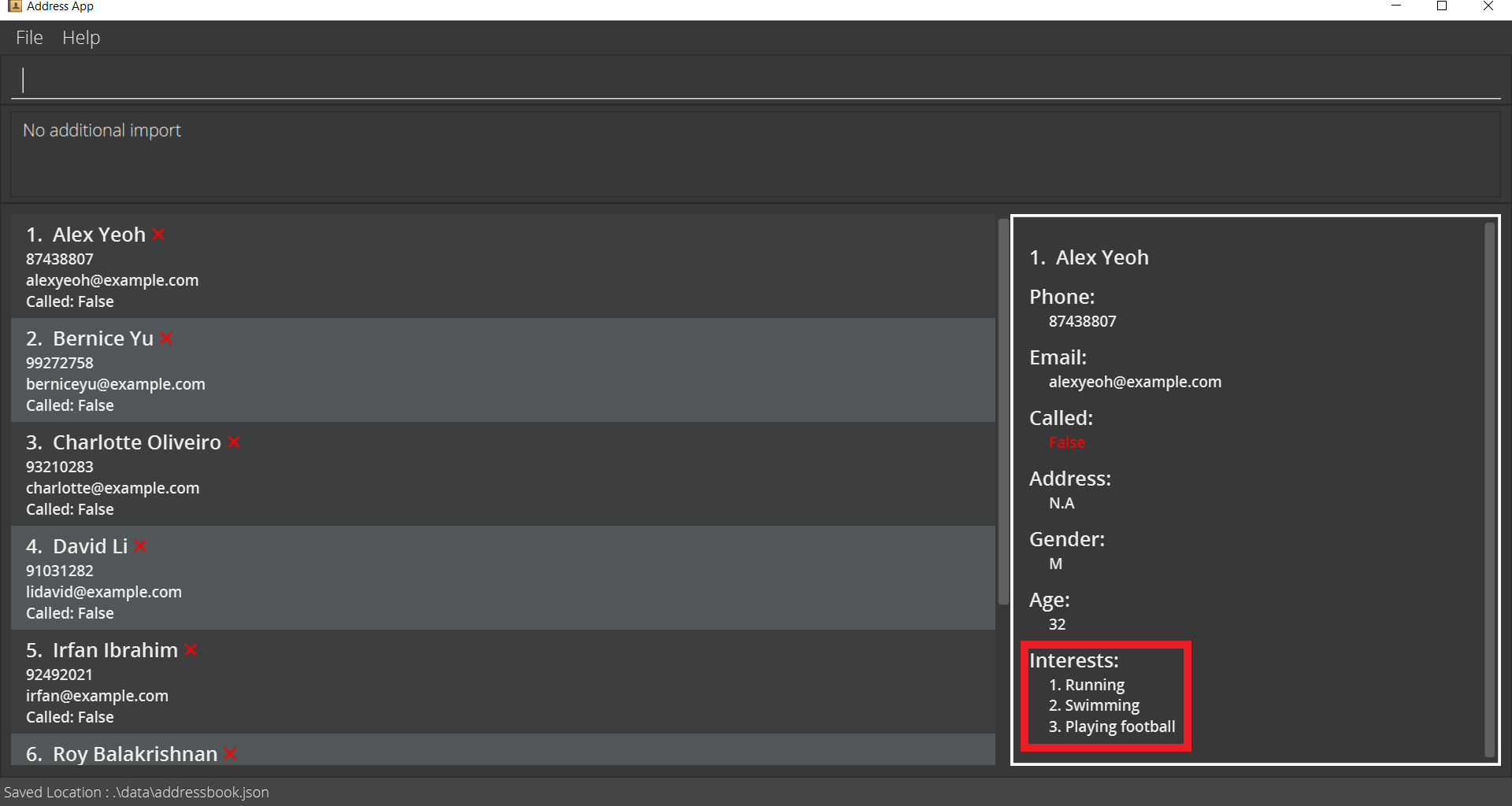
![]() Tip:
Tip:
-
If all 3 operations are specified in the same command, editing the interest is always done first, followed by removing, then adding the interest.
-
Specifying (INTERESTLIST INDEX) is optional as well
-
If (INTERESTLIST INDEX) is specified, the interest at that index would be updated
-
If it is not, then an interest would be added to the list instead
-
You can refer to the example below for a better understanding of the edit command functionality
Example:
-
edit 1 n/Malan g/F i/Painting i/(2) SwimmingEdits the following fields of the first contact in the displayed list :-
Edit
Nameto ‘Malan’ -
Edit
Genderto ‘F’ -
Adds ‘painting’ as a new
Interest -
Edits the second
Interestto ‘Swimming’
-
The screenshot below shows the expected result.
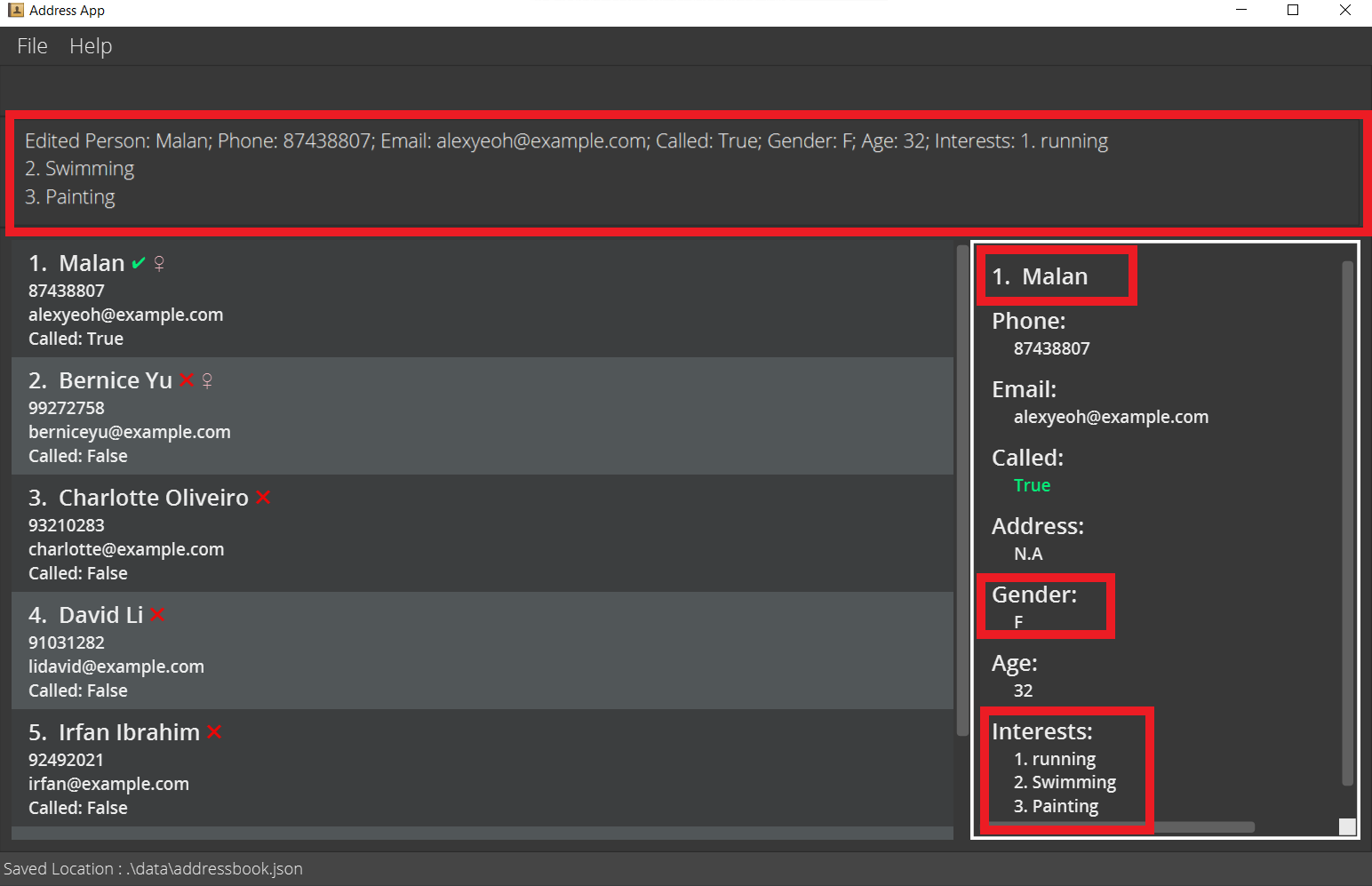
Common issues:
-
The index provided is invalid:
a. Displayed list does not contain contact at
INDEX -
The interests list index provided is invalid:
a. Displayed interests list does not contain an interest at
INTERESTSLIST INDEX -
Invalid command format!:
a. No fields provided
b. Used the wrong prefix. (e.g., ‘i/[1]’ instead of ‘i/(1)’)
-
Invalid command arguments:
a. Duplicate of the edited contact already exists on the address book
(e.g., editing name from ‘Bob’ to ‘bob’ is not allowed. Since names are case-insensitive, both ‘Bob’ and ‘bob’ are recognised as the same name)
5.5 Deleting a contact : delete
Deletes the specified contact from the CMM database.
Format: delete INDEX
Example:
-
delete 2deletes the second contact in the displayed list
Things to note:
-
INDEXrefers to the index number shown in the displayed contacts list -
INDEXmust be a positive integer (e.g., 1, 2, 3, …)
Common issues:
-
The index provided is invalid:
a. Displayed list does not contain contact at
INDEXb. Index specified is larger than 2147483647
c. Index specified is not a positive integer
5.6 Finding contacts that match ANY of the keywords specified: findAny
Finds any contacts that match any of the fields specified by the user
Format: findAny [n/NAME…] [p/PHONE…] [e/EMAIL…] [a/ADDRESS…] [g/GENDER…] [age/AGE…]
[c/CALLED…] [i/INTEREST…]
Things to note:
-
FindAny requires at least one field. But it is optional for you to include all the fields
-
If there are duplicate fields, CMM will only take the right-most field
(e.g.,findAny n/alex n/davidreturns the same results asfindAny n/david) -
The search is case-insensitive.
(e.gn/hanswill return the same resultn/Hans) -
Any number of keywords can be specified within each field
-
The order of the keywords within each field does not matter.
(e.g.,n/Hans Bowill return the same result asn/Bo Hans) -
Keywords for
Calledare limited totrue,false,t,f -
Keywords for
Genderare limited tomale,female,m,f -
All the fields are case-insensitive
-
You can refer to the example below for a better understanding
![]() Tip: FindAny vs FindAll
Tip: FindAny vs FindAll
-
findAnysearches for contacts that satisfy ANY of the fields specified -
findAllsearches for contacts that satisfy ALL the fields specified
Click here to learn more about findAll
Example:
-
findAny findAny n/o p/87Finds all contacts that have either the letteroin their name or the substring ‘87’ in their phone number or both
The screenshot below shows the expected result.
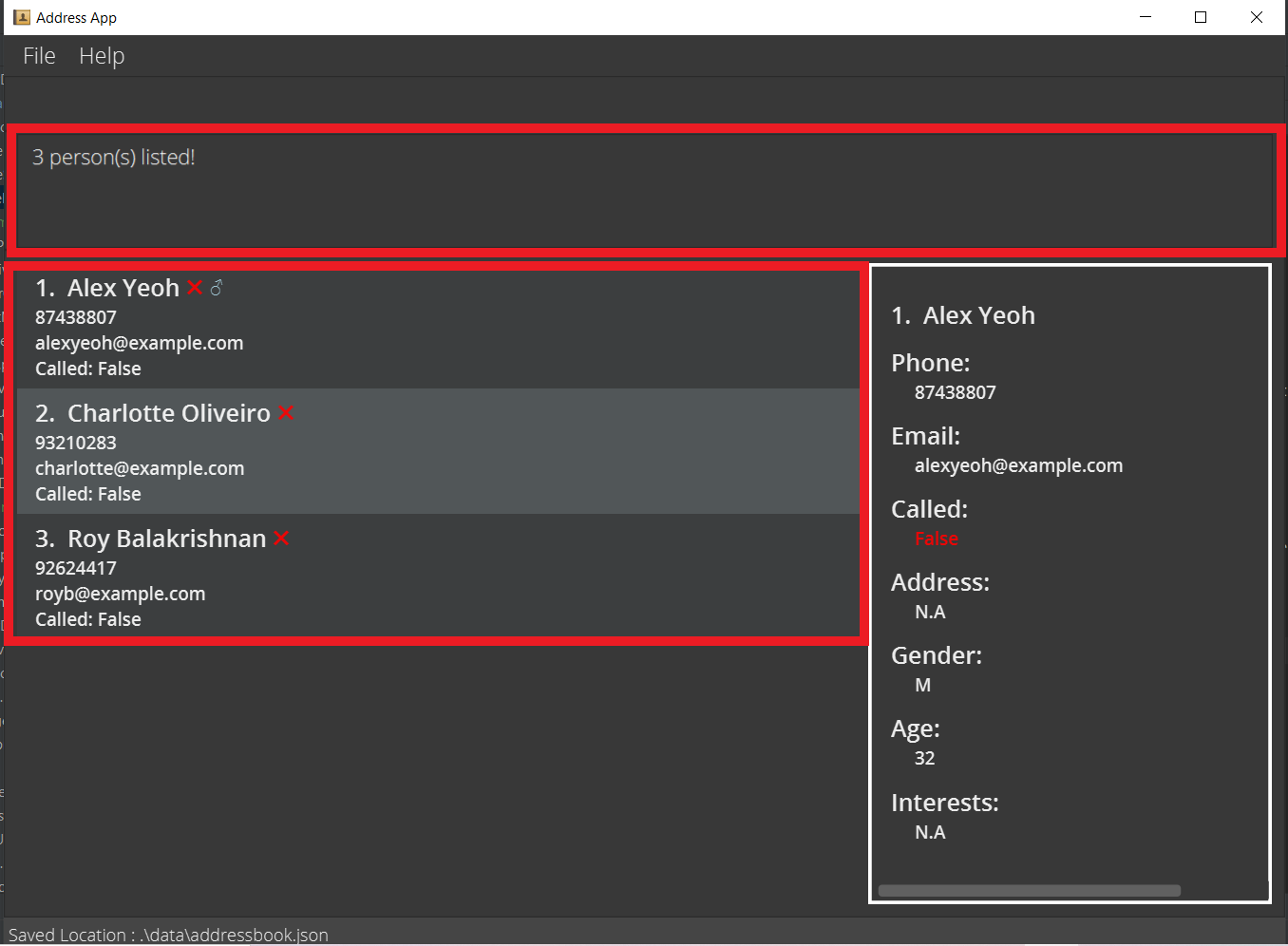
Common issues:
-
Unknown command:
a. Using
findanyinstead offindAny(not capitalising the ‘A’) -
Invalid command format!:
a. No fields provided
b. Used the wrong prefix (eg. ‘/n’ instead of ‘n/’)
c. Did not specify either ‘t’, ‘f’, ‘true’, ‘false’ after
c/d. Did not specify either ‘m’, ‘f’, ‘male’, ‘female’, ‘n.a’ after
g/
5.7 Finding contacts that match ALL the keywords specified : findAll
Format: findAll [n/NAME…] [p/PHONE…] [e/EMAIL…] [a/ADDRESS…] [g/GENDER…] [age/AGE…] [c/CALLED…] [i/INTEREST…]
Finds only the contacts that match all the keywords specified in their respective fields
Things to note:
-
findAllrequires at least one field. But it is optional for you to include all the fields. -
If there are duplicate fields, CMM will only take the right-most field
(e.g.,findAll n/alex n/davidreturns the same results asfindAny n/david) -
The search is case-insensitive. e.g.,
findAll n/hanswill return the same resultfindAll n/Hans -
Any number of keywords can be specified within each field
-
The order of the keywords within each field does not matter.
(e.g.,n/Hans Bowill return the same result asn/Bo Hans) -
Keywords for
Calledare limited totrue,false,t,f -
Keywords for
Genderare limited tomale,female,m,f -
All the fields are case-insensitive
-
You can refer to the example below for a better understanding
![]() Tip: FindAll vs FindAny
Tip: FindAll vs FindAny
-
findAllsearches for contacts that satisfy ALL the fields specified. -
findAnysearches for contacts that satisfy ANY of the fields specified.
Click here to learn more about findAny
Example:
-
findAll n/o p/87Finds all contacts that have both the letter ‘o’ in their name and the substring ‘87’ in their phone number
The screenshot below shows the expected result.
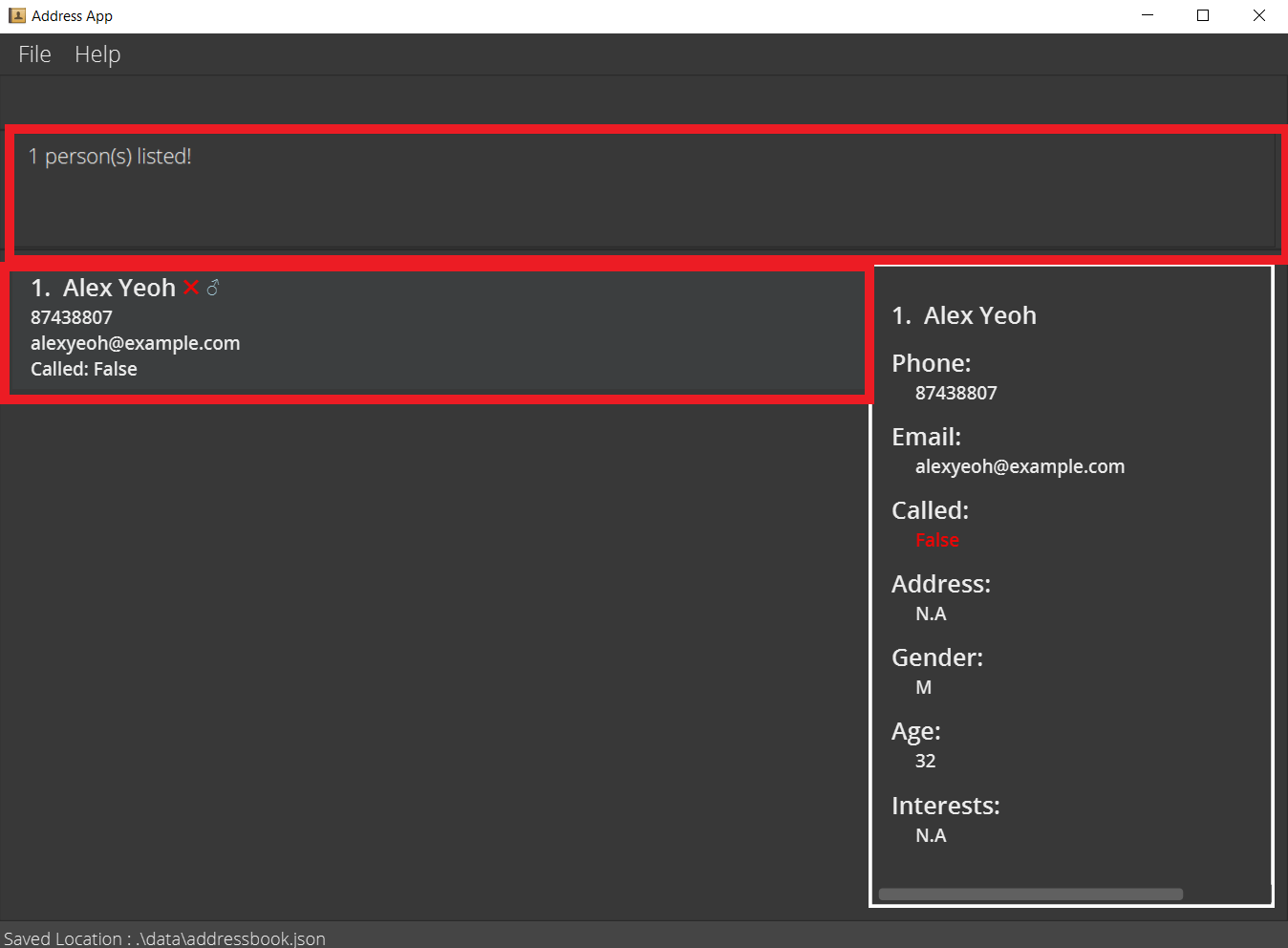
Common issues:
-
Unknown command:
a. Using
findallinstead offindAll(not capitalising the ‘A’) -
Invalid command format!:
a. No fields provided
b. Used the wrong prefix (e.g., ‘/n’ instead of ‘n/’)
c. Did not specify either ‘t’, ‘f’, ‘true’, ‘false’ after
c/d. Did not specify either ‘m’, ‘f’, ‘male’, ‘female’, ‘n.a’ after
g/
5.8 Displaying full contact details : display
Displays additional information of a particular contact stored in the application. These include the
Address, Gender, Age and their Interests.
You can find the full details of the displayed contact in the Person Card (refer to the screenshot below).
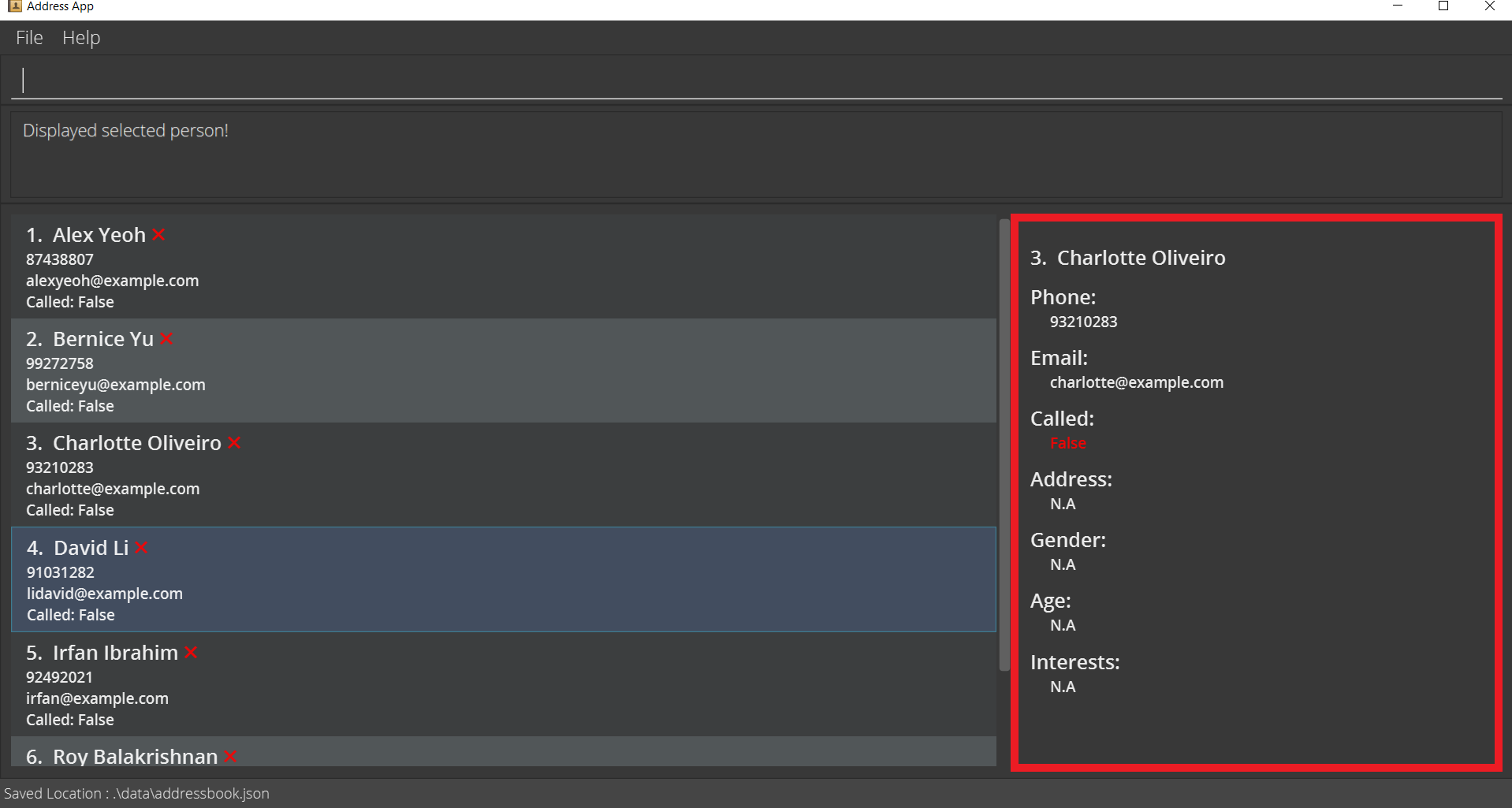
Format: display INDEX
Things to note:
-
INDEXrefers to the index number shown in the displayed list -
INDEXmust be a positive integer (e.g., 1, 2, 3, …)
Example:
-
display 3displays full contact details of the 3rd contact in the displayed list
The screenshot below shows the expected result.
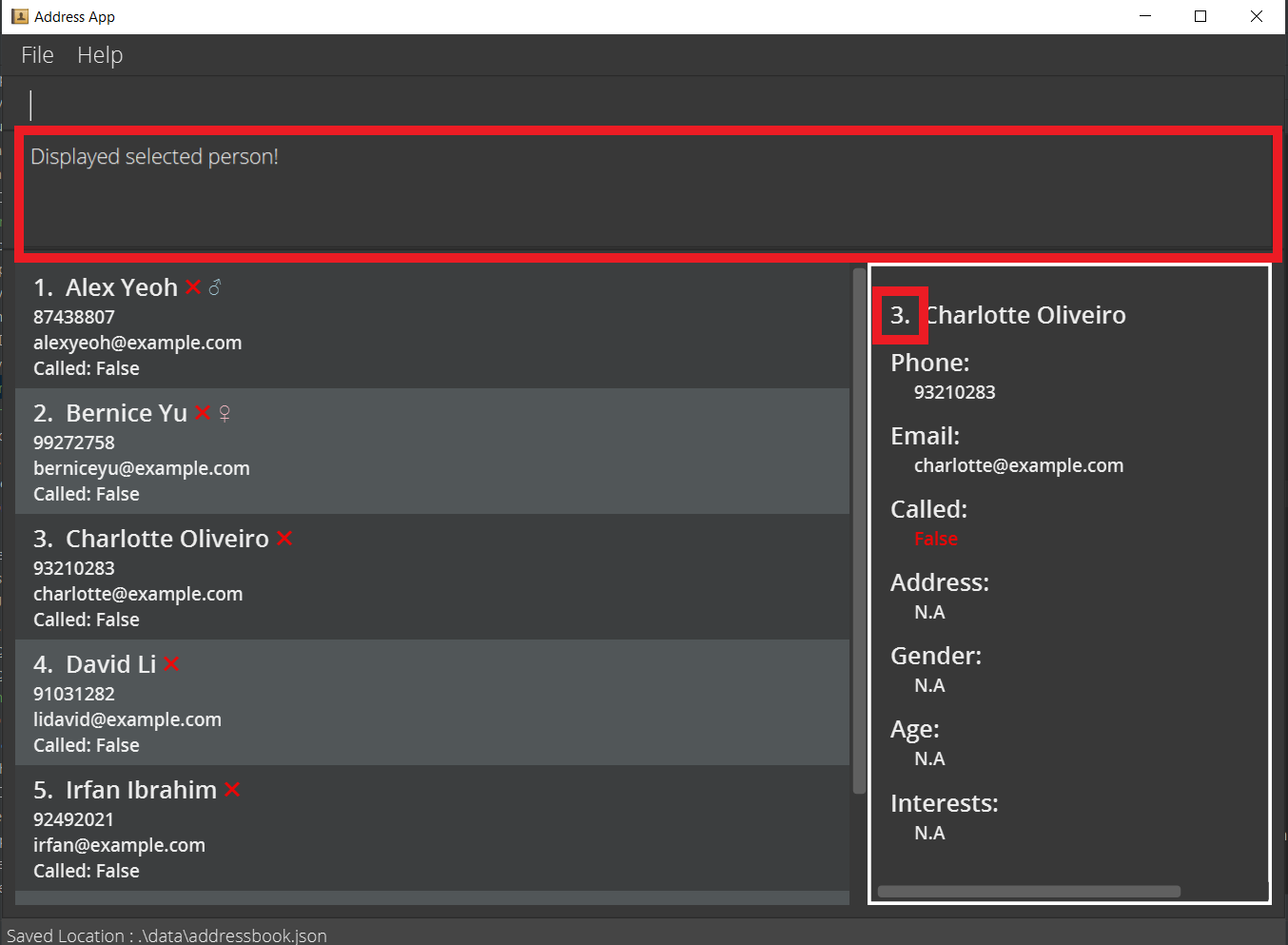
Common issues:
-
The index provided is invalid:
a. Displayed list does not contain contact at
INDEXb. Index specified is larger than 2147483647
c. Index specified is not a positive integer
5.9 Filtering contacts : filter
Filters the existing contacts in the CMM database. The displayed list will show contacts sorted by the chosen category.
Format: filter CATEGORY [COUNT]
Things to note:
-
CATEGORYfield is mandatory -
CATEGORYrefers to the category used to filter the contacts -
CATEGORYmust be one of the following: called, gender -
COUNTrefers to the number of contacts to be shown in the displayed list. IfCOUNTis more than the total number of contacts, all contacts will be shown -
COUNTmust be a positive integer less than 2147483648 (e.g., 1, 2, 3, …, 2147483647 ) -
If more arguments are given than what is required, the last two arguments are taken into account (e.g.,
filter gender called 2will be interpreted asfilter called 2) -
If the last argument is not an integer, it will be interpreted as a
CATEGORY(e.g.,filter gender calledwill be interpreted asfilter called) -
If you enter more than one category, the last category will be interpreted as the
CATEGORY(e.g.,filter gender called 3will be interpreted asfilter called 3) -
If only one argument is given, it will be interpreted as a
CATEGORY(e.g.,filter 1000will cause1000to be interpreted as aCATEGORY)
Example:
-
filter called 2Filters the displayed list to prioritise uncalled contacts and limits the size of the list to 2
The screenshot below shows the expected result.
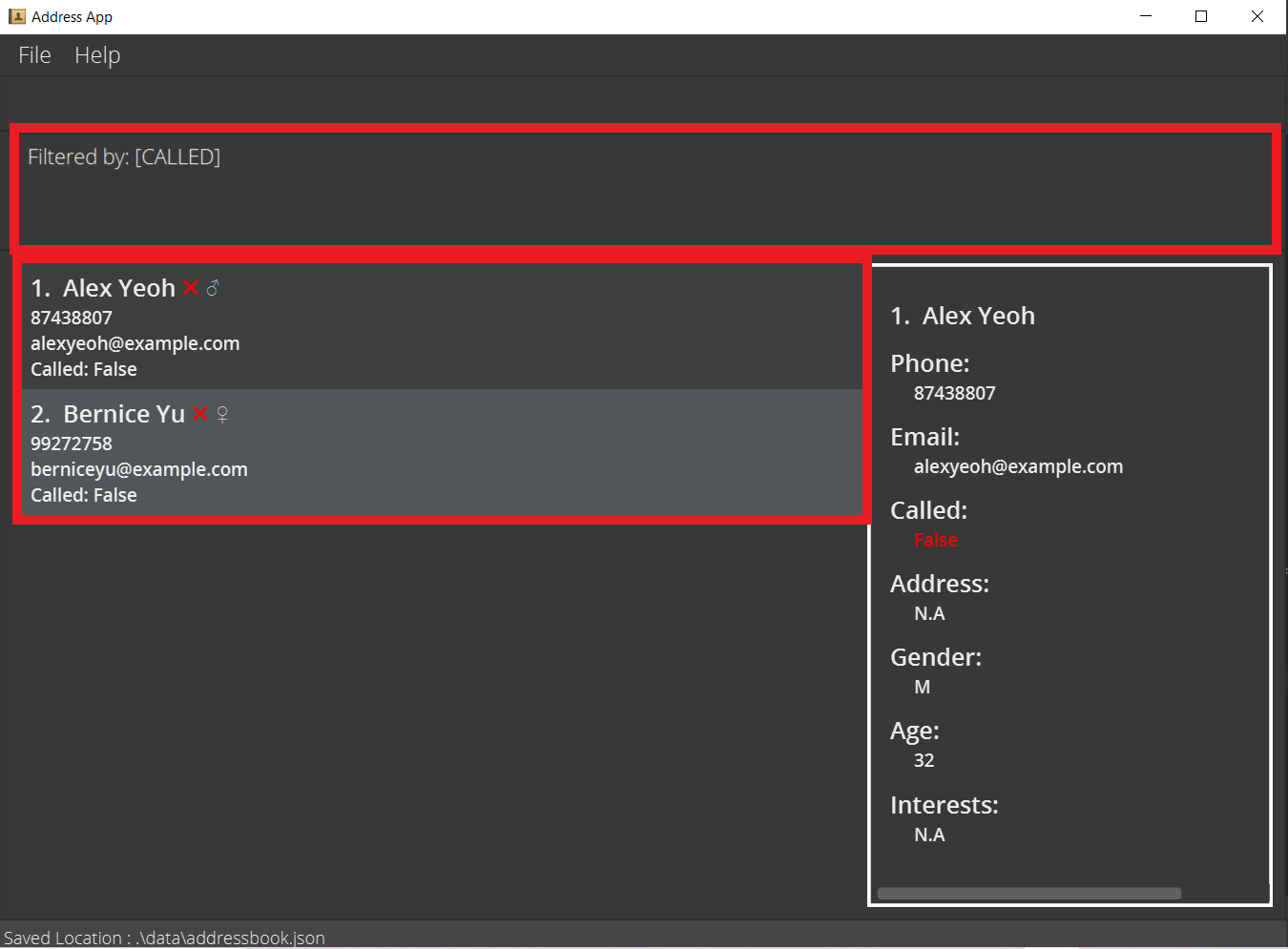
Common issues:
-
Invalid command format!:
a. No fields provided
-
Category can only be either “called” or “gender”:
a. The category specified is not
calledorgenderb. Category not specified
-
Count is not a non-zero unsigned integer. It cannot be bigger than 2147483647 (i.e., MAX_VALUE):
a. The last argument is not a positive integer
b. The last argument is bigger than 2147483647
5.10 Clearing all contacts : clear
Clears all contacts from the CMM database.
Format: clear
5.11 Viewing help : help
Shows a message explaining how to access the User Guide.

Format: help
5.12 Exiting the program : exit
Exits the program.
Format: exit
5.13 Saving the data
CMM data are saved in the hard disk automatically after any command that changes the data. There is no need to save manually.
5.14 Importing the data into database
CMM is able to import Excel files into CMM. The import files have to be in an Excel Csv format (semicolon delimited).
Steps to Import from Excel file:
-
Ensure that the Excel file is a CSV file type that is semicolon delimited.
Instructions on how to import to this file type can be found here.
-
Ensure that the import file is named import.csv under the “data” folder found in the same directory as the CMM jar file.
-
Upon CMM application startup, a prompt will popup with 3 options :
Add On Imports,Start New Using Import,Don't Import. The popup will look like the image below:

Import options:
Add On Imports
- Adds on new imports into existing database
Start New Using Import
-
Exports and reset the current database. CMM will then populate the reset database with new imports
-
Previous database before import can be found in a CSV file under the “data” folder found in the same directory as the CMM jar file. It will have the following file name :
export[Date HH:MM:SS].csv
Don't Import
-
CMM will not import anything and application will start normally
-
Closing the prompt will also choose this option
Things to note:
-
CMM will prompt user for imports upon every application startup
-
CMM will not import data rows with missing details (Compulsory for data to have
Name,Phone,Emailfilled) -
CMM will treat two people with the exact
Name,Phone,Emailas duplicates -
CMM will update duplicate imports only when
Calledstatus is true -
Interestcolumn in the csv should be seperated using a comma within the same cell -
Import is only allowed during application startup. To import after the startup, simply reopen application to get the import prompt
-
Unsuccessful file import will result in an empty database. The previous database can be recovered in the latest export file
Common Issues:
-
CSV file not found in data\import.csv
-
This could either mean that the file does not exist at the specified location or
-
The file was incorrectly named. File has to be named
import.csv
-
-
Missing/Extra Headers, Please check file
-
Files has invalid headers
-
First row of Excel file is reserved for datatype headers.
-
Headers must include
Name,Phone,Email,Address,Gender,Age,InterestandCalledfrom the left to right, starting from the cell ‘A1’ -
Headers are not case-sensitive
-
-
File may have incorrect CSV type. Please refer to this guide to correctly format your file.
-
-
Wrong header detected,please double check file
-
Files has invalid headers. Please refer to Common issue
Missing/Extra Headers, Please check fileto resolve
-
Files has invalid headers. Please refer to Common issue
-
Data not imported despite correct import file placement, naming AND headers
- File may not be in the correct CSV type. Please refer to this guide to correctly format your file.
-
Unable to understand why a specific row was not able to be imported
-
Row could either be duplicate or there was an error reading the row
-
Detailed reasons for any import error can be found in the logs of the CMM
-
5.15 Exporting state of database
CMM is able to export the current database as semicolon delimited CSV files. As such, there is no need for you to ensure that the formatting is right for future use.
Steps to Export data as CSV file:
-
Closing the application in any way would prompt user to export the current database.
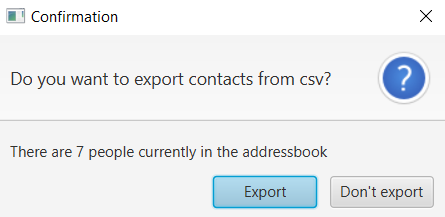
-
The CMM will export the database to the data file location.
-
Export file will have the following file name :
export[Date HH:MM:SS].csvwhere date and time will follow your system settings.
How to find the exported file:
-
Go to the directory that the CMM jar file is stored in and click on the ‘data’ folder.

-
You can find the exported CSV file here.

5.16 Editing the data file (JSON)
AddressBook data are saved as a JSON file [JAR file location]/data/addressbook.json. Advanced users are welcome to update data directly by editing that data file.
If your changes to the data file makes its format invalid, AddressBook will discard all data and start with an empty data file at the next run.
6. FAQ
Q: How do I transfer my data to another Computer?
A: Install the app in the other computer and overwrite the empty data file it creates with the file that contains the data of your previous AddressBook home folder.
Data found can be found at [JAR file location]/data/addressbook.json.
Q: How do I install Java for my computer
A: Head over to Installing Java to find the installation guide.
Q: How do I know what version of Java I have running on my computer?
A: Steps to checking your Java version can be found here
——————————————————————————————————————–
7. Troubleshooting
7.1 Installing Java
You can follow these guides to install Java 17:
7.2 Checking Java version
-
Open the Command line.
-
Windows: Type ‘cmd’ in the windows search bar and press enter
-
MacOS: Use the keyboard shortcut Command + Space to bring up the search bar, then type in ‘terminal’ and press enter
-
Linux: Use the keyboard shortcut ctrl + alt + T
Click here for other ways to open the Command line if the above shortcuts do not work for you.
 Note: The screenshots below use the Windows Command Line as examples. However, the Command Lines for
the other Operating Systems should be similar.
Note: The screenshots below use the Windows Command Line as examples. However, the Command Lines for
the other Operating Systems should be similar.Once done, you should see an interface similar to the screenshot below.
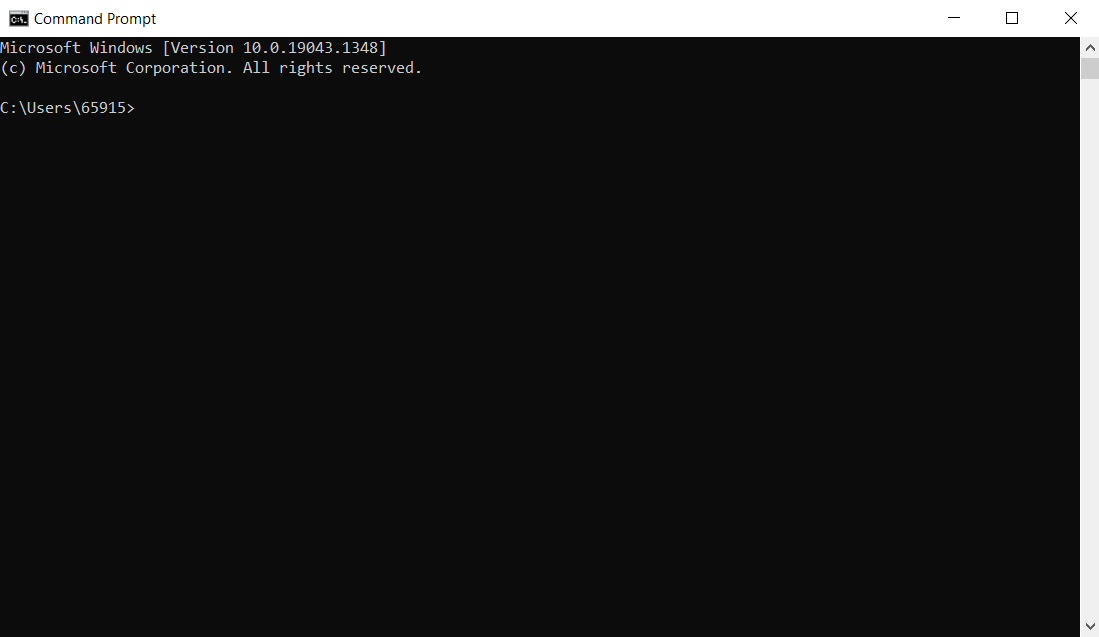
-
-
Enter the command ‘java -version’ and press enter.
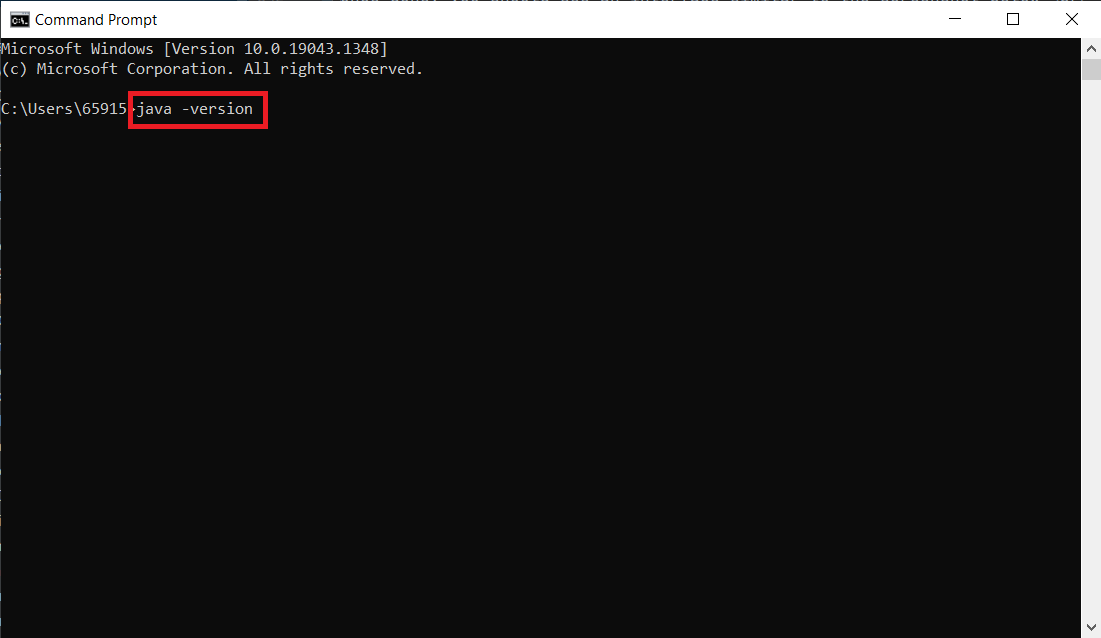
-
The Java version will be displayed here. As long as you have a Java version higher than 11, CMM will work as expected.
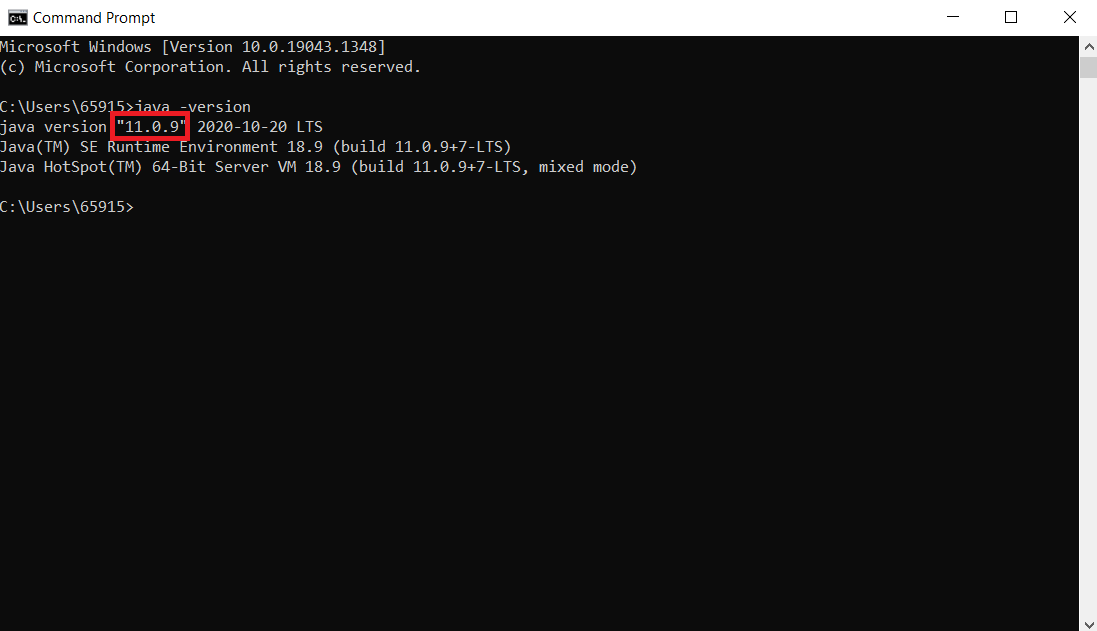
-
If you get a response similar to the one below, it is likely that you do not have Java installed, or did not properly set up Java after installing. Head over to Installing Java to find the steps to easily fix this problem.
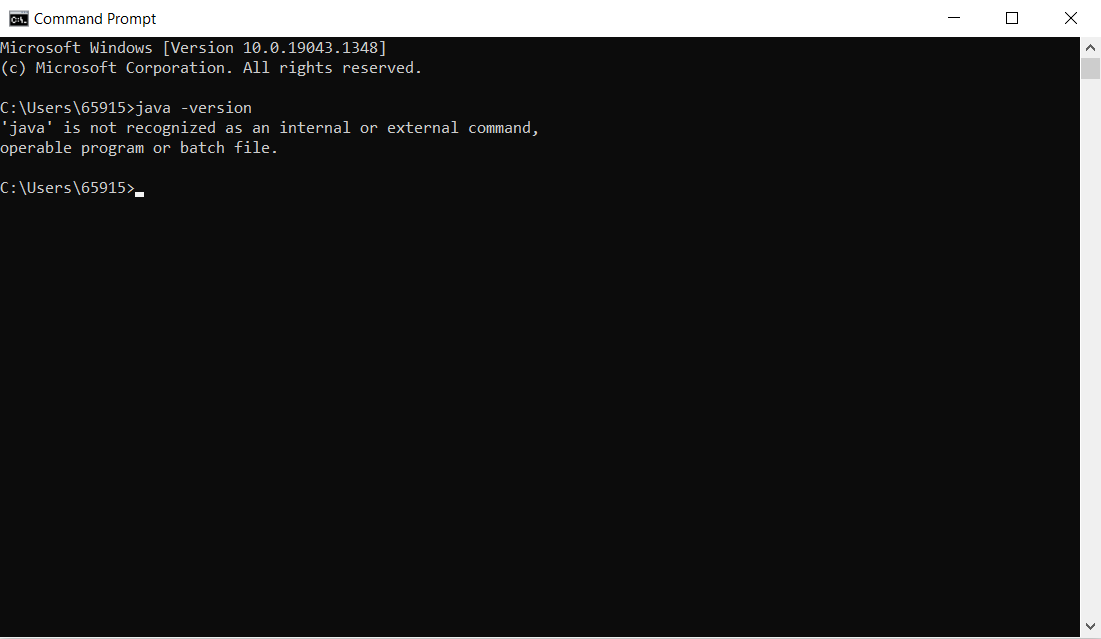
8. Command summary
| Action | Format, Examples |
|---|---|
| Add |
add n/NAME p/PHONE_NUMBER e/EMAIL [a/ADDRESS] [g/GENDER] [age/AGE] [i/INTEREST]… e.g., add n/Labuschagne Ho p/22224444 e/labuschagne@example.com a/my house g/F age/95 i/Sleeping
|
| List | list |
| Called |
called INDEX e.g., called 2
|
| Edit |
edit INDEX [n/NAME] [p/PHONE] [e/EMAIL] [a/ADDRESS] [g/GENDER] [age/AGE] [c/CALLED] [i/(OPTIONAL INTERESTSLIST INDEX) INTEREST]... [i/(INTERESTSLIST INDEX) remove]... [i/INTEREST]... e.g., edit 1 n/Bob p/68889444 e/email@email.com a/his house g/M age/33 i/Eating i/(2) Swimming
|
| Delete |
delete INDEXe.g., delete 3
|
| FindAny |
findAny [n/NAME…] [p/PHONE…] [e/EMAIL…] [a/ADDRESS…] [g/GENDER…] [age/AGE…] [d/DONE…] [i/INTEREST…]e.g., findAny n/alex g/m
|
| FindAll |
findAll [n/NAME…] [p/PHONE…] [e/EMAIL…] [a/ADDRESS…] [g/GENDER…] [age/AGE…] [d/DONE…] [i/INTEREST…]e.g., findAll n/alex g/m
|
| Display |
display INDEX e.g., display 4
|
| Filter |
filter CATEGORY [COUNT] e.g., filter gender 5
|
| Clear | clear |
| Exit | exit |
| Help | help |
Thank you for reading the User Guide. Hope you have a pleasant experience with CallMeMaybe.